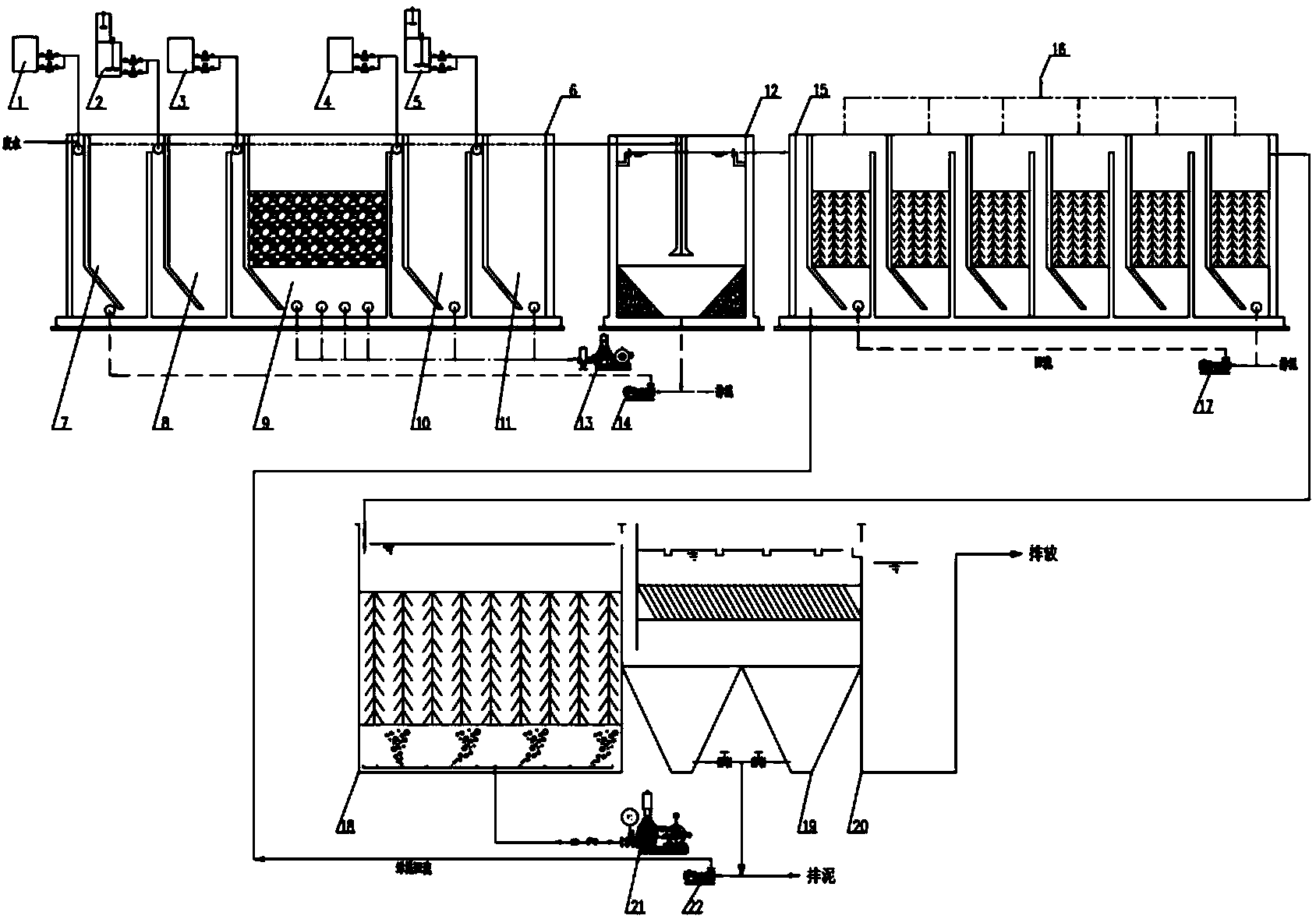Advanced oxidation-biological treatment device for non-biodegradable waste water
A refractory biodegradation and advanced oxidation technology is applied in the field of new devices for the treatment of refractory biodegradable wastewater, which can solve the problems of reduced methane production efficiency, deterioration of anaerobic process, low utilization rate, etc. The effect of reducing weight and reducing energy consumption
- Summary
- Abstract
- Description
- Claims
- Application Information
AI Technical Summary
Problems solved by technology
Method used
Image
Examples
Embodiment 1
[0047] The advanced oxidation-biological treatment device for refractory biodegradable wastewater is used to treat wastewater from a printing and dyeing factory with a COD concentration of 850mg / L. The device includes the following process steps:
[0048] (1) The waste water to be treated is pumped into the baffle plate Fenton reactor 6 from the sump well. First waste water enters the acid adding pond 7. Turn on the acid adding device 1, add nitric acid / sulfuric acid (1:1) mixed acid to the front end of the acid adding pool, adjust the pH to about 3.0, and use the ferrous adding device 2 to add ferrous nitrate 50mg / L to the ferrous adding pool 8 , at the inlet end of Fenton main reaction tank 9, through H 2 o 2 Dosing device 3 adds 350mg / L H 2 o 2 , and reacted in Fenton main reaction tank 9 for 30 minutes. After the reaction is complete, enter the alkali-adding pool 10, add NaOH to adjust the pH to 9.0 with the alkali-adding device 4, and then add 2 mg / L anion PAM to the...
Embodiment 2
[0053] The advanced oxidation-biological treatment device for refractory biodegradable wastewater is used to treat a certain chemical wastewater with a COD concentration of 1980 mg / L. The device includes the following process steps:
[0054] (1) The sewage to be treated is pumped into the baffle plate Fenton reactor 6 from the sump well. First waste water enters the acid adding pond 7. Turn on the acid adding device 1, add nitric acid / sulfuric acid (1:1) mixed acid to the front end of the acid adding pool, adjust the pH to about 3.5, and use the ferrous adding device 2 to add ferrous nitrate 160 mg / L to the ferrous adding pool 8 , at the inlet end of Fenton main reaction tank 9, through H 2 o 2 Dosing device 3 adds 1000mg / L H 2 o 2 , and reacted in Fenton main reaction tank 9 for 50 minutes. After the reaction is complete, enter the alkali-adding pool 10, add NaOH to adjust the pH to 9.5 with the alkali-adding device 4, and then add 3 mg / L anion PAM to the front end of th...
Embodiment 3
[0059] The advanced oxidation-biological treatment device for refractory biodegradable wastewater is used to treat wastewater from a pharmaceutical factory with a COD concentration of 4572 mg / L. The device includes the following process steps:
[0060] (1) The sewage to be treated is pumped into the baffle plate Fenton reactor 6 from the sump well. First waste water enters the acid adding pond 7. Turn on the acid adding device 1, add nitric acid / sulfuric acid (1:1) mixed acid to the front end of the acid adding pool, adjust the pH to about 3.5, and use the ferrous adding device 2 to add ferrous nitrate 500mg / L to the ferrous adding pool 8 , at the inlet end of Fenton main reaction tank 9, through H 2 o 2 Dosing device 3 adds 3000mg / L H 2 o 2 , reacted in Fenton main reaction tank 9 for 80min. After the reaction is complete, enter the alkali-adding pool 10, and use the alkali-adding device 4 to add NaOH to adjust the pH to 8.5, and then add 4 mg / L anion PAM to the front en...
PUM
 Login to View More
Login to View More Abstract
Description
Claims
Application Information
 Login to View More
Login to View More - R&D
- Intellectual Property
- Life Sciences
- Materials
- Tech Scout
- Unparalleled Data Quality
- Higher Quality Content
- 60% Fewer Hallucinations
Browse by: Latest US Patents, China's latest patents, Technical Efficacy Thesaurus, Application Domain, Technology Topic, Popular Technical Reports.
© 2025 PatSnap. All rights reserved.Legal|Privacy policy|Modern Slavery Act Transparency Statement|Sitemap|About US| Contact US: help@patsnap.com

